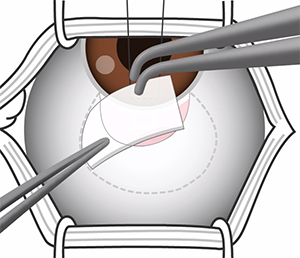Advancing Clinical Education With State-of-the-Art Learning Tools

Thanks to a generous donation from David E. I. Pyott, CBE, MD(Hon), new instructional videos on the ONE Network combine surgical footage with detailed step-by-step animation.
2017 was a year of educational evolution at the Academy, marked by the development of a new glaucoma education center and the launch of a new clinical journal dedicated to retinal disease.
Speeding Online Medical Training in Glaucoma Treatment
When David E. I. Pyott, CBE, MD(Hon), past chairman and CEO of Allergan, pledged $2 million to the Academy Foundation for glaucoma education, he wanted to provide instruction to eye care providers globally and allow for easy sharing of information among them. The new online David E. I. Pyott Glaucoma Education Center makes publicly available most of the Ophthalmic News and Education (ONE®) Network glaucoma content. The center also introduces many new features to complement the ONE Network’s existing educational materials that include:
- Surgical video and animation. The center offers fresh perspectives on surgeries by showing videos of procedures accompanied by animation clearly illustrating each step.
- Interactive maps and data. Epidemiologic and incidence data come alive through an interactive map that quickly conveys basic information for each U.S. state.
- Diagnosis and treatment algorithms. The center lets the clinician specify a disease (POAG, PACG, etc.) and navigate stepwise through each decision needed to arrive at a management algorithm — all designed for use on your smartphone.
- Gonioscopy videos. The Color Atlas of Gonioscopy, now available through the center, gives users access to clinical videos of procedures for the angle.
Showcasing Top-Tier Research for Retina Subspecialists Globally
In response to the growing volume and quality of retina research, the Academy launched a new clinical journal: Ophthalmology® Retina. It focuses exclusively on retina-related eye diseases and conditions and publishes original research of interest to retina specialists worldwide.
With this increased exposure to retina-specific manuscripts, ophthalmologists will be better able to stay on top of the latest advances in medical drug treatment, surgery, technology and science.
“A devoted retina journal provides subspecialists with cutting-edge research and just-in-time insights to better serve patients,” said Andrew P. Schachat, MD, editor-in-chief of Ophthalmology Retina. “In an environment that is constantly changing, it’s important that we equip our colleagues with everything they need to choose appropriate emerging treatments. Ophthalmology Retina will be a valuable resource for retina specialists around the world.”